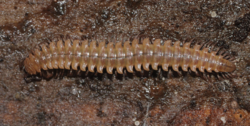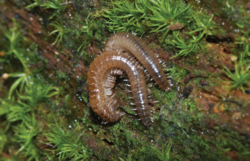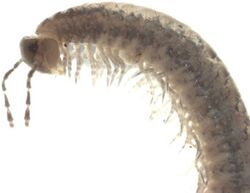Biology:Chordeumatida
| Chordeumatida | |
|---|---|

| |
| Two unidentified species from New Zealand | |
| Scientific classification | |
| Domain: | Eukaryota |
| Kingdom: | Animalia |
| Phylum: | Arthropoda |
| Subphylum: | Myriapoda |
| Class: | Diplopoda |
| Subterclass: | Eugnatha |
| Superorder: | Nematophora |
| Order: | Chordeumatida Pocock, 1894 |
| Suborders | |
|
Chordeumatidea | |
| Diversity | |
| c. 50 families, 1200 species | |
| Synonyms | |
|
Ascospermophora Verhoeff, 1900 | |
Chordeumatida (from the Greek word for "sausage") is a large order of millipedes containing some 1200 species with a nearly worldwide distribution. Also known as sausage millipedes,[1] they grow and develop through a series of moults, adding segments until they reach a fixed number in the adult stage, which is usually the same for a given sex in a given species, at which point the moulting and the addition of segments and legs stop.[2] This mode of development, known as teloanamorphosis, distinguishes this order from most other orders of millipedes, which usually continue to moult as adults, developing through either euanamorphosis or hemianamorphosis.[2][3]
Description
Chordeumatidans are relatively short-bodied, with only 26 to 32 body segments (including the telson) behind the head. They range in length from 4–25 mm (0.16–0.98 in). A key feature is the presence of 6 large bristles (setae) on the dorsal surface of each body segment. The first segment (collum) is relatively narrow, giving the appearance of a distinct "neck" in many species. The body tapers towards the rear, and the rearmost tip (telson) contains silk-producing organs (spinnerets). A dorsal groove runs down the length of the body, and some species possess paranota, lateral extensions of the exoskeleton. Paranota are also found in some other millipedes, notably Polydesmida, from which Chordeumatidans can be distinguished by having a dorsal groove. Unlike most other helminthomorph (worm-like) millipedes, chordeumatidans lack ozopores.[4][5]
Most chordeumatidan species have 30 body segments (including the telson) as adults, and adult females in these species have 50 leg pairs.[2][6] In adult males in this order, two leg pairs (pair 8 and pair 9) are modified into gonopods, leaving 48 pairs of walking legs in the typical adult male chordeumatidan.[7][2] Many species in this order, however, deviate from this typical body plan.
Many chordeumatidan species deviate from the usual 30 segments: A few species have 26 segments as adults (e.g., Chamaesoma broelemanni and Opisthocheiron canayerensis), many species have 28 (e.g., Lipseuma josianae[8]), one genus features 29 (Tianella, in which all but two species have 29[9]), one species (Metamastigophorophyllon martensi) features 31, and many species have 32 (e.g., Altajosoma kemerovo[10]).[2] Some species also deviate by featuring sexual dimorphism in segment number, specifically, adult males with two segments fewer than adult females, for example, in the family Buotidae (males with 26, females with 28),[11] in Xystrosoma beatense (males with 28, females with the usual 30),[2] and in the family Peterjohnsiidae (males with the usual 30, females with 32).[12]
With these deviations from the usual 30 segments, the number of leg pairs in adults changes, usually with two leg pairs added or subtracted for each segment added to or subtracted from the typical number.[6] For example, in Chamaesoma broelemanni, with only 26 segments (four fewer than the typical number), adult females have only 42 leg pairs, and adult males have only 40 pairs of walking legs (excluding two pairs of gonopods).[13][2] Adult females with 32 segments (two more than the typical number) have 54 leg pairs (e.g., in the family Peterjohnsiidae[12]), which is the maximum number fixed by species in the class Diplopoda.[14]
Many species deviate from the expected number of walking legs, however, because they deviate in terms of sex-linked modifications to their legs. For example, many species involve another leg pair in addition to pairs 8 and 9 in the gonopod complex in adult males. In the family Speophilosomatidae, leg pair 7 in adult males is modified as part of the gonopod complex.[15] In many species, the gonopod complex instead includes leg pair 10 in addition to pairs 8 and 9 (e.g., Branneria carinata,[16] Reginaterreuma monroei,[12] Golovatchia magda, and Hoffmaneuma exiguum[17]). The family Chordeumatidae exhibits the most extensive modifications, including five leg pairs (pairs 7 through 11) in the gonopod complex.[7][2] Some species also deviate from the usual body plan by reducing or eliminating leg pairs in the adult female. In the family Chordeumatidae, for example, adult females feature a legless sternite (the "platosternite") where a third pair of legs would otherwise be.[7][2][6] In other species (e.g., the genus Kashmireuma and the species Vieteuma longi), adult females instead exhibit modifications to the second pair of legs, which are reduced to small nubbins.[18]
Distribution
Chordeumatidans have a large distribution, occurring on all continents except Antarctica. They are present in Madagascar but absent from sub-Saharan Africa and, aside from southern Chile , are largely absent from South America. They occur in the tropics of Central America, Southeast Asia, and Oceania, and as far south as Tasmania, New Zealand, and Chiloé Island, Chile.[19] They are abundant in cold, rocky, mountainous areas of Europe and central Asia, and range northward to Scandinavia, Siberia, and in North America up into Canada and southwest Alaska.[19]
Classification
Chordeumatida contains approximately 1200 species,[20][21] classified in four suborders and approximately 50 families, although several families contain only one to five genera.[22]
- Suborder Chordeumatidea Pocock 1894
- Superfamily Chordeumatoidea C. L. Koch, 1847
- Chordeumatidae C. L. Koch, 1847
- Speophilosomatidae Takakuwa, 1949
- Suborder Craspedosomatidea Cook, 1895
- Superfamily Anthroleucosomatoidea Verhoeff 1899
- Anthroleucosomatidae Verhoeff 1899
- Haasiidae Hoffman, 1980
- Origmatogonidae Verhoeff 1914
- Vandeleumatidae Mauriès, 1970
- Superfamily Brannerioidea Cook, 1896
- Brachychaeteumatidae Verhoeff, 1910
- Branneriidae Cook, 1896
- Chaemosomatidae Verhoeff, 1913thumb|Craspedosoma'' (Craspedosomatidae) from Belgium
- Golovatchiidae Shear, 1992
- Heterolatzeliidae Verhoeff 1899
- Kashmireumatidae Mauriès, 1982
- Macrochaeteumatidae Verhoeff, 1914
- Microlympiidae Shear & Leonard, 2003
- Niponiosomatidae Verhoeff, 1941
- Tingupidae Loomis, 1966
- Trachygonidae Cook, 1896
- Superfamily Cleidogonoidea Cook, 1896
- Biokoviellidae Mrsic, 1992
- Cleidogonidae Cook, 1896
- Entomobielziidae Verhoeff, 1899
- Lusitaniosomatidae Schubart, 1953
- Opisthocheiridae Ribaut, 1913
- Trichopetalidae Verhoeff, 1914
- Superfamily Craspedosomatoidea Gray in Jones, 1843
- Attemsiidae Verhoeff, 1899
- Craspedosomatidae Gray in Jones, 1843
- Haplobainosomatidae Verhoeff, 1909
- Superfamily Haaseoidea Attems, 1899
- Haaseidae Attems, 1899
- Superfamily Neoatractosomatoidea Verhoeff, 1901
- Altajellidae Mikhaljova & Golovatch, 2001
- Cyrnosomatidae Mauriès, 2003
- Faginidae Attems, 1926
- Hoffmaneumatidae Golovatch, 1978
- Mastigophorophyllidae Verhoeff, 1899
- Neoactractosomatidae Verhoeff, 1901
- Superfamily Verhoeffioidea Verhoeff, 1899
- Verhoeffiidae Verhoeff, 1899
- Suborder Heterochordeumatidea Shear, 2000
- Superfamily Conotyloidea Cook, 1896
- Adritylidae Shear, 1971
- Conotylidae Cook, 1896
- Superfamily Diplomaragnoidea Attems, 1907
- Diplomaragnidae Attems, 1907
- Superfamily Heterochordeumatoidea Pocock, 1894
- Eudigonidae Verhoeff, 1914
- Heterochordeumatidae Pocock, 1894
- Megalotylidae Golovatch, 1978
- Metopidiotrichidae Attems, 1907
- Peterjohnsiidae Mauriès, 1987
- Superfamily Pygmaeosomatoidea Carl, 1941
- Lankasomatidae Mauriès 1978
- Pygmaeosomatidae Carl, 1941
- Suborder Striariidea Cook, 1896
- Superfamily Caseyoidea Verhoeff, 1909
- Caseyidae Verhoeff, 1909
- Urochordeumatidae Silvestri, 1909
- Superfamily Striarioidea Bollman, 1893
- Apterouridae Loomis, 1966
- Buotidae Shear, 2009
- Rhiscosomididae Silvestri, 1909
- Striariidae Bollman, 1893
References
- ↑ Henen, Derek; Brown, Jeff (in English). Millipedes of Ohio. Ohio Division of Wildlife. pp. 3, 24. https://ohiodnr.gov/static/documents/wildlife/backyard-wildlife/Millipedes+of+Ohio+Pub+5527.pdf.
- ↑ 2.0 2.1 2.2 2.3 2.4 2.5 2.6 2.7 2.8 Enghoff, Henrik; Dohle, Wolfgang; Blower, J. Gordon (1993). "Anamorphosis in Millipedes (Diplopoda) — The Present State of Knowledge with Some Developmental and Phylogenetic Considerations". Zoological Journal of the Linnean Society 109 (2): 103–234. doi:10.1111/j.1096-3642.1993.tb00305.x. https://academic.oup.com/zoolinnean/article-abstract/109/2/103/2646268?redirectedFrom=fulltext.
- ↑ Fusco, Giuseppe (December 2005). "Trunk segment numbers and sequential segmentation in myriapods.". Evolution & Development 7 (6): 608–617. doi:10.1111/j.1525-142X.2005.05064.x. PMID 16336414. https://onlinelibrary.wiley.com/doi/abs/10.1111/j.1525-142X.2005.05064.x. Retrieved 25 August 2020.
- ↑ "Millipede Body Organization". Milli-PEET: The class Diplopoda. The Field Museum, Chicago. 9 February 2012. http://fieldmuseum.org/explore/milli-peet-millipede-body-organization.
- ↑ "Putative apomorphies of millipede clades". Milli-PEET: Millipede Systematics. The Field Museum, Chicago, IL. 26 September 2006. http://fieldmuseum.org/sites/default/files/millipede_apomorphies.pdf.
- ↑ 6.0 6.1 6.2 Enghoff, Henrik; Golovatch, Sergei; Short, Megan; Stoev, Pavel; Wesener, Thomas (2015-01-01). "Diplopoda — taxonomic overview" (in en). Treatise on Zoology - Anatomy, Taxonomy, Biology. The Myriapoda, Volume 2: 363–453. doi:10.1163/9789004188273_017. ISBN 9789004156128. https://brill.com/view/book/edcoll/9789004188273/B9789004188273_017.xml.
- ↑ 7.0 7.1 7.2 Blower, J. Gordon (1985). Millipedes : keys and notes for the identification of the species. Linnean Society of London, Estuarine and Brackish-water Sciences Association. London: Published for the Linnean Society of London and the Estuarine and Brackish-Water Sciences Association by E.J. Brill. ISBN 90-04-07698-0. OCLC 13439686. https://www.worldcat.org/oclc/13439686.
- ↑ Golovatch, Sergei I.; Geoffroy, Jean-Jacques; Mauries, Jean-Paul (2006). "Four new Chordeumatida (Diplopoda) from caves in China" (in en). Zoosystema 28 (1): 75–92. https://sciencepress.mnhn.fr/en/periodiques/zoosystema/28/1/quatre-nouveaux-chordeumatida-diplopoda-de-grottes-de-chine.
- ↑ Mauriès, Jean-Paul (1988). "Myriapodes du Népal. II. Diplopodes Craspedosomides nouveaux de l'Himalaya et de la région indo-malaise (Craspedosomidea et Chordeumidea)" (in French). Revue suisse de zoologie 95: 3–49. doi:10.5962/bhl.part.79638. ISSN 0035-418X. https://www.biodiversitylibrary.org/part/79638.
- ↑ Shear, William A. (1990). "On the Central and East Asian milliped family Diplomaragnidae (Diplopoda, Choredeumatida, Diplomaragnoidea)" (in en-US). American Museum Novitates (2977). https://digitallibrary.amnh.org/handle/2246/5072.
- ↑ Shear, William A. (2009-11-16). "Buotidae, a new family for the minute North American milliped Buotus carolinus (Chamberlin) 1940 (Diplopoda, Chordeumatida, Striarioidea)". Zootaxa 2290 (1): 41–49. doi:10.11646/zootaxa.2290.1.4. ISSN 1175-5334.
- ↑ 12.0 12.1 12.2 Mauries, Jean-Paul (1987). "Craspedosomid Millipedes Discovered in Australia: Reginaterreuma, Neocambrisoma and Peterjohnsia, New Genera (Myriapoda: Diplopoda: Craspedosomida)". Memoirs of the Queensland Museum 25 (1): 107–133. https://www.biodiversitylibrary.org/page/40653793#page/109/mode/1up.
- ↑ David, Jean-Francois (1989). "Le cycle biologique de Chamaesoma broelemanni Ribaut et Verhoeff, 1913 (Diplopoda, Craspedosomatida) en forêt d'Orléans (France)" (in French). Bulletin du Muséum National d'Histoire Naturelle, Section A 4:11 (3): 639–647. doi:10.5962/p.288286. https://www.biodiversitylibrary.org/page/58850871#page/169/mode/1up.
- ↑ Fusco, Giuseppe (2005). "Trunk segment numbers and sequential segmentation in myriapods" (in en). Evolution & Development 7 (6): 608–617. doi:10.1111/j.1525-142X.2005.05064.x. ISSN 1520-541X. PMID 16336414. https://onlinelibrary.wiley.com/doi/10.1111/j.1525-142X.2005.05064.x.
- ↑ Shear, William A.; Tsurusaki, Nobuo; Tanabe, Tsutomu (1994). "Japanese chordeumatid millipeds. I. On the genus Speophilosoma Takakuwa (Diplopoda, Chordeumatida, Speophilosomatidae)". Myriapodologica 3 (4): 25–36. https://www.vmnh.net/content/vmnh/uploads/PDFs/research_and_collections/myriapodologica/myriapodologica_v3_n4.pdf.
- ↑ Shear, William A. (2003-07-04). "Branneria bonoculus, n. sp., a second species in the North American milliped family Branneriidae (Diplopoda: Chordeumatida: Brannerioidea)". Zootaxa 233 (1): 1–7. doi:10.11646/zootaxa.233.1.1. ISSN 1175-5334. https://www.researchgate.net/publication/229029916.
- ↑ Shear, William A. (1992). "Golovatchia, new genus, and Golovatchiidae, from the Far East of the Russian Republic, with a comment on Hoffmaneumatidae (Diplopoda: Chordeumatidae)". Myriapodologica 3 (4): 25–36. https://www.vmnh.net/content/vmnh/uploads/PDFs/research_and_collections/myriapodologica/myriapodologica_v2_n10.pdf.
- ↑ Shear, William A. (2002). "Five New Chordeumatidan Millipeds from China: New Species of Vieteuma (Kashmirieumatidae) and Nepalella (Megalotylidae)". Proceedings of the California Academy of Sciences 53 (6): 63–72. https://www.biodiversitylibrary.org/page/15778525#page/77/mode/1up.
- ↑ 19.0 19.1 Shelley, R. M.; Golavatch, S. I. (2011). "Atlas of myriapod biogeography. I. Indigenous ordinal and supra-ordinal distributions in the Diplopoda: Perspectives on taxon origins and ages, and a hypothesis on the origin and early evolution of the class". Insecta Mundi 158: 1–134. http://digitalcommons.unl.edu/insectamundi/677/.
- ↑ Sierwald, Petra; Bond, Jason E. (2007). "Current Status of the Myriapod Class Diplopoda (Millipedes): Taxonomic Diversity and Phylogeny". Annual Review of Entomology 52 (1): 401–420. doi:10.1146/annurev.ento.52.111805.090210. PMID 17163800.
- ↑ Brewer, Michael S.; Sierwald, Petra; Bond, Jason E. (2012). "Millipede Taxonomy after 250 Years: Classification and Taxonomic Practices in a Mega-Diverse yet Understudied Arthropod Group". PLOS ONE 7 (5): e37240. doi:10.1371/journal.pone.0037240. PMID 22615951. Bibcode: 2012PLoSO...737240B.
- ↑ Shear, W. (2011). "Class Diplopoda de Blainville in Gervais, 1844. In: Zhang, Z.-Q. (Ed.) Animal biodiversity: An outline of higher-level classification and survey of taxonomic richness". Zootaxa 3148: 159–164. doi:10.11646/zootaxa.3148.1.32. http://www.mapress.com/zootaxa/2011/f/zt03148p164.pdf.
External links
- Chordeumatida of Tasmania
- North American Chordeumatida on BugGuide.net
Wikidata ☰ Q4300743 entry
 |




